Spider mites are the most common pests of both indoor and outdoor plants. Spider mites on houseplants wreak havoc on indoor plants because the interior spaces provide ideal conditions for growth and reproduction.

Healthy and happy houseplants giving peace to indoor garden owners
Spider mite infestation can not only impact the healthy state of affected plants but also kills them. Therefore, it is essential to use treatment as soon as possible to prevent spider mites. So, this (early treatment of spider mites) is the only way to keep indoor plants healthy and happy.
Let’s understand spider mites, their life cycle, identification, and how we can get rid of them for good.
What Are Spider Mites?
Spider mites are piercing-sucking pests that can kill host plants in high numbers. These tiny pests suck plant nutrients and interrupt their photosynthesis (food-making process). They turn the foliage into pale yellow with a stippled appearance.
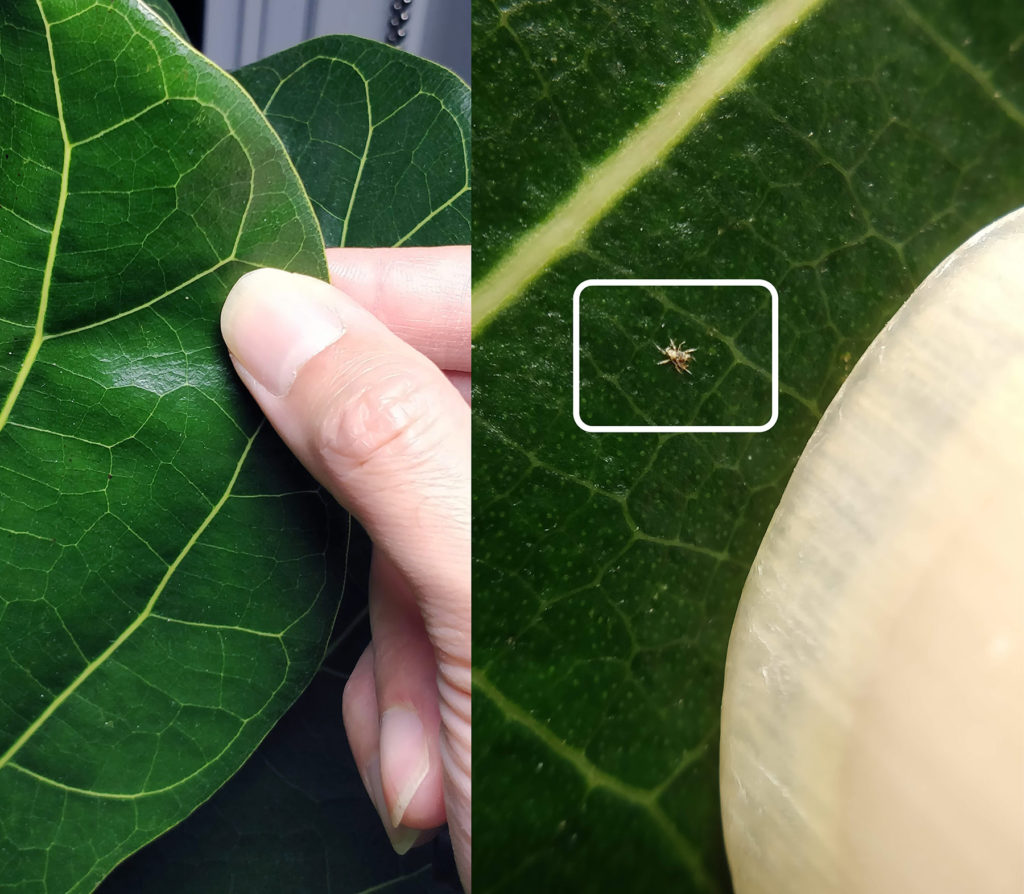
Spider mites on a houseplant
Essential Characteristics Of Spider Mites
| Family | Tetranychidae |
| Class | Arachnids |
| Distribution | North America |
| Hosts | Indoor and outdoor plants |
| Body-color | Reddish-brown or pale |
| Size | 1/50 inch long |
| Feeding habit: | Feed-in large groups on the underside of leaves |
Spider mites are members of class arachnids and are not actual insects. These tiny pests are eight-legged with a voracious appetite for foliage. Spider mites are mostly found on the underside of leaves in large colonies and suck out plant juices for growth and reproduction.
What Causes Spider Mites On Indoor Plants?
Spider mites are closely related to spiders and ticks. Just like these two, spider mites are microscopic. They love being indoors because of the warm, dry air and lack of natural predators. These two conditions are perfect for spider mite infestation and multiplication.
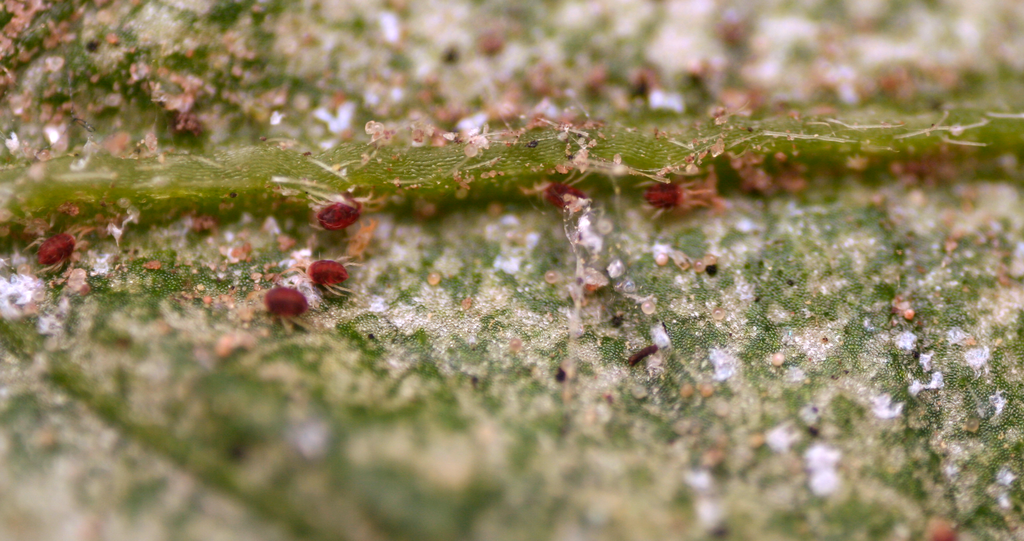
The cluster of spider mites on the underside of a leaf
Moreover, in indoor environments, spider mites are also present near heating vents and A/C because the dry air is perfect for them. Therefore, they thrive on houseplants and severely damage their aesthetic value.
Note: One of the best ways to detect spider mites’ infestations on indoor plants is to check plants for webbing. They are responsible for finding web formation on the underside of heavily infected leaves.
Related: How To Get Rid Of Spider Mites For Good? A Comprehensive Guide
Damage Caused By Spider Mites On Indoor Plants
Spider mites feed on plant nutrients. They have specialized mouthparts such as piercing (a long needle-like structure—stylet) to suck out plant juices. They provide in large groups, which turn the leaves yellow and dry with light green colored patches all over the infested plant parts.
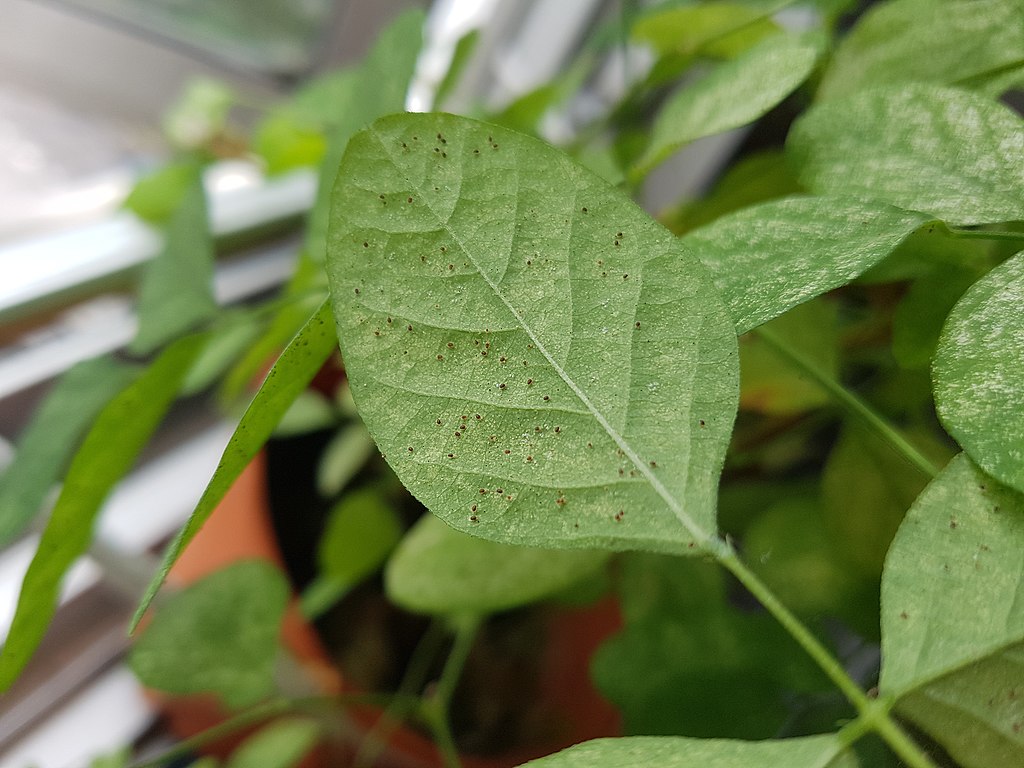
Heavily infested plant leaves with spider mites, and their feeding marks
The spider mite damage also includes the drying of an entire plant with the dropping of leaves. The most apparent damage of spider mites is on plant leaves, which comprises the development of small dots.
These tiny creatures inject toxins into the host plant’s leaves, thus discoloring and twisting them. Spider mites also suck out the chlorophyll of affected leaves and turn them into chlorotic and damaged leaves.
Spider mites are so small that you won’t be able to see them through the naked eye. Place a white paper below the affected plant foliage to check houseplants for a spider mite infestation. Tap the leaves with fingers or a pen; then, you may find the small reddish-brown spider mites on a paper sheet with a magnifying glass.

Two-spotted spider mite—most common pest of houseplants
The most common spider mite on houseplants is the two-spotted spider mite. The adult spider mites appear as reddish-brown or pale yellow with oval-shaped bodies. They have eight legs and piercing mouthparts.
Under a magnifying glass, the spider mites are transparent, with two dark spots on each side of the body. All the spider mites are the worst enemies of many plants.
Host Plants Of Spider Mites
The outdoor and indoor plants are susceptible to spider mite damage. The outdoor and indoor host plants include
| Outdoor Host Plants | Indoor Host Plants |
| Tomatoes, beans, squash, pumpkin, cucumbers | Milky Way or Cast iron plant, Kiwi, and Madagascar palm, Petra |
| Eggplant, and strawberries | Chamaedorea elegans. (parlor palm), or the herbaceous plants with tend foliage and flowers |
Moreover, spider mite damage is more widespread in warm, dry areas, and it appears as fine white webbing.
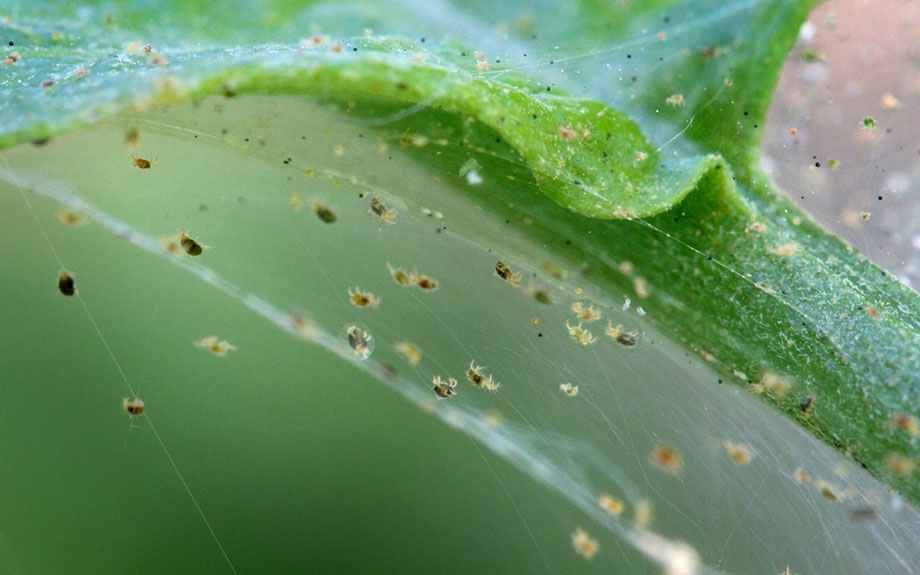
White fine webbing by spider mites infestation on the underside of plant leaves
Life Cycle Of Spider Mites
The life cycle of spider mites comprises three stages—eggs, nymphs, and adults. The adult spider mites overwinter as eggs on the leaves and stem bark of infested leaves.
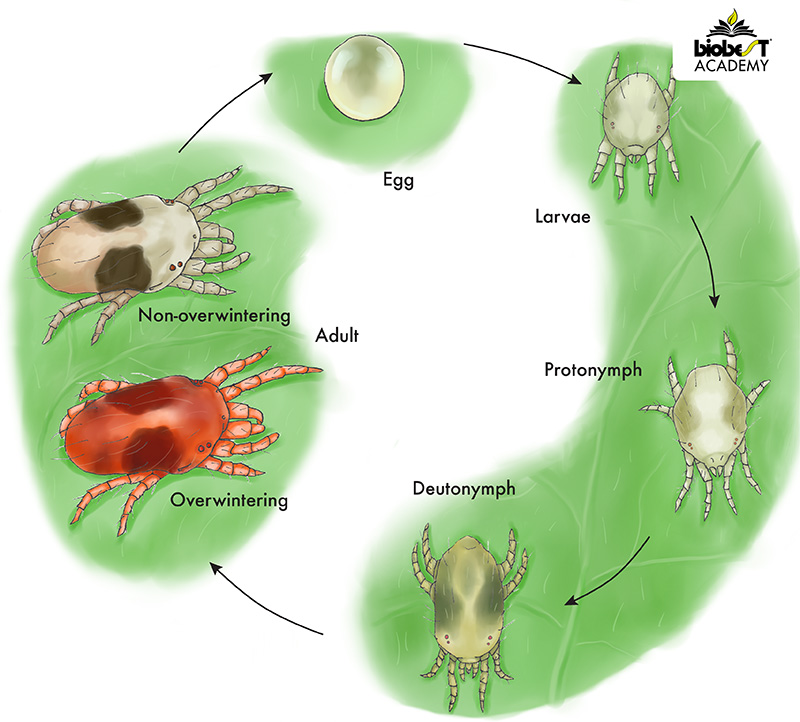
The complete life cycle of spider mites from eggs to the adult stage
In early spring, the temperature rises, and the small six-legged young or nymphs emerge from eggs. Right after hatching from eggs, the larvae start feeding on the leaves of plants. They provide in large clusters and also inject toxins into plant leaves.
The larvae feed for a few days and then hide to molt into the first nymphal stage. These nymphs have eight legs and are similar to their adults but smaller. After first molting, they again start feeding on tend growths of houseplants. After three to four molts, the nymphs become mature adults.
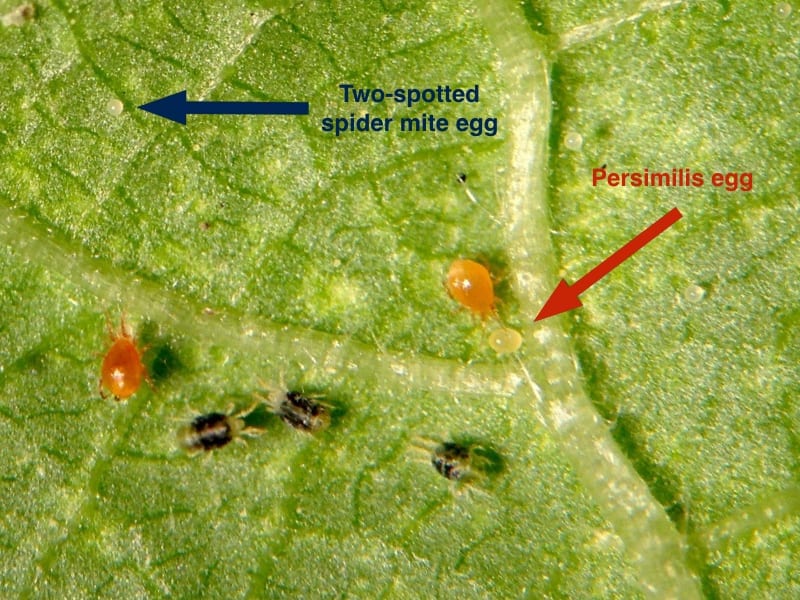
Eggs of two-spotted spider mites on an infested plant leaf
The hot, dry weather favors egg production, and female spider mites lay as many as 300 eggs within one to two weeks. As the favorable weather persists, they transform from egg to adult spider mites within a time of 5 days. Therefore, the infested plants have several overlapping generations per year.
What Are The Signs And Symptoms Of Spider Mite Infestation?
Spider mites infestations have the following signs and symptoms:
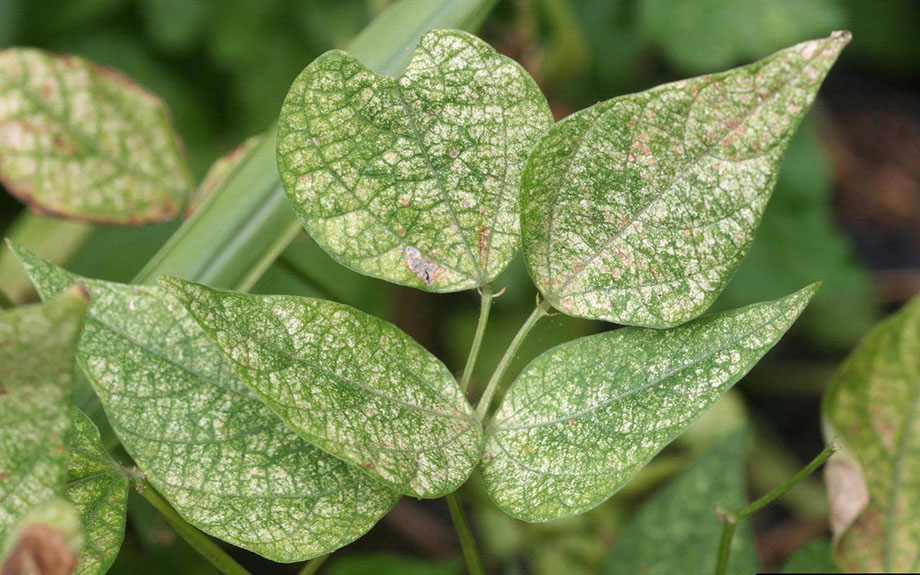
Foliage stippling and bleaching is the first sign of spider mite infestation
The second sign of an infestation is the development of fine webbing.
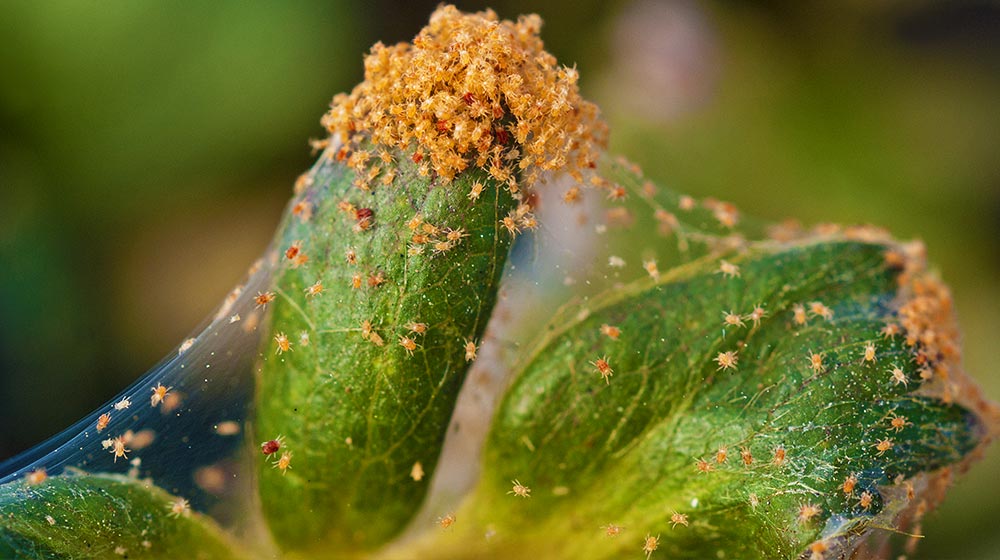
A close-up of red spider mite infestation on strawberry leaves. It also has fine webbing with clusters of spider mites and their eggs.
In case of severe infestations, the leaves of affected plants fall and may die. Therefore, to prevent spider mite damage, regular monitoring for spider mites is crucial.
How to treat spider mites in chemical and natural ways:
How To Get Rid Of Spider Mites?
Spider mites prefer dry environments with low humidity levels. Therefore, the indoor environments are ideal for their establishment and nourishment.
Getting rid of spider mites on indoor plants is not difficult. However, the early recognition of these tiny creatures is vital. Following are the best methods to control these houseplant pests.
- Spray with liquid dish soap
- Use rubbing alcohol
- Encourage natural predators
- Use neem oil
- Use apple cider vinegar spray
- Use pyrethroid pesticides
- Spray insecticidal soap
- Use horticultural oils
- Spray chemical pesticides to control spider mite problem
Regular Monitoring For Spider Mites
- During the warm, dry season, regularly check your plants, particularly from the underside. If you find your plants infested with spider mites, consider removing them from other healthy plants.
- Keep the soil moist to discourage the ideal conditions for spider mites. Because the cool and moist environment will prevent the establishment of adults and nymphs, do not let the soil be saturated with water to attract root rot or other houseplant pests.
- Use strong water streams to wash off the tiny mites, their eggs, and nymphs. You can also use a damp cloth to wipe out all the spider mites. Repeat this process regularly to eliminate the problem. Once the problem is gone, try a biweekly high-pressure water stream.
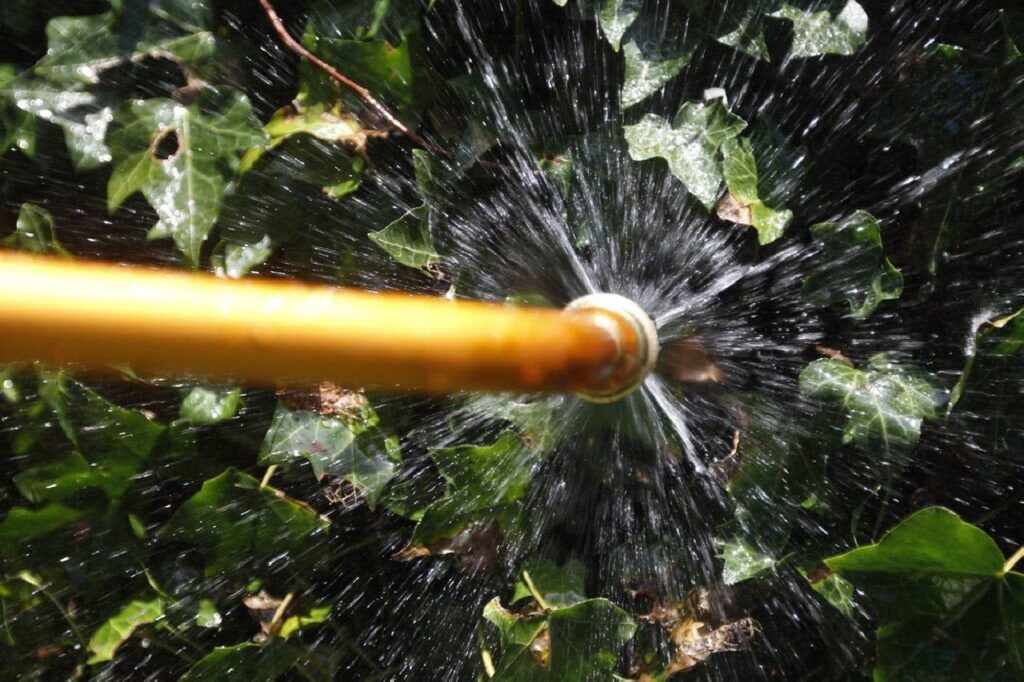
Use a high water stream to hose off the spider mites to prevent the damage
Prune Off The Infested Plant’s Leaves
The timely identification and cutting of infested branches, twigs, and leaves will prevent the other plants from being damaged. The best way is to discard the damaged and trimmed plant parts completely.
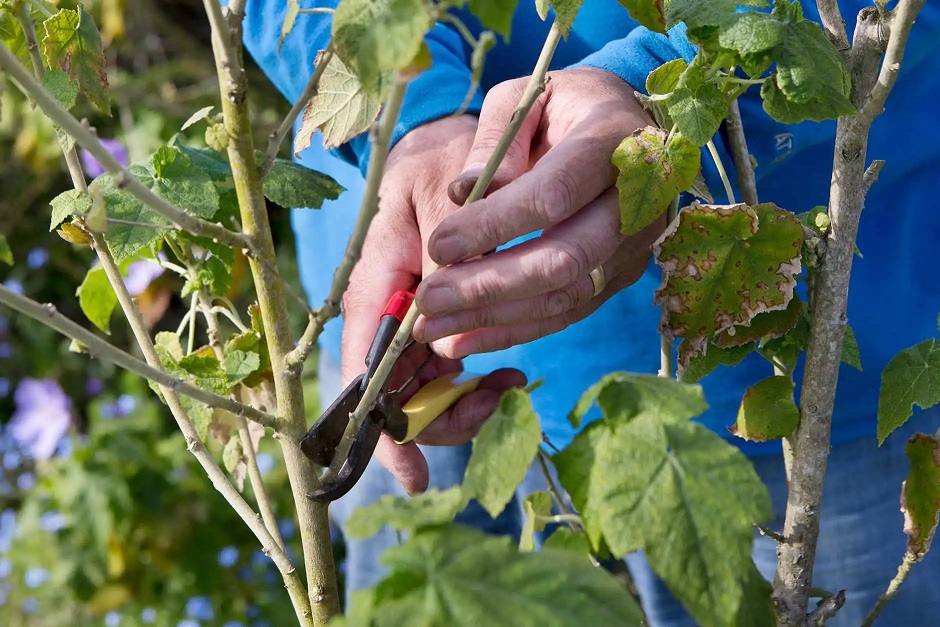
Pruning damaged plant parts (branches, twigs, and leaves) will prevent further damage spread of spider mites
Spray With Liquid Dish Soap
One of the best and easiest spider mite treatments involves spraying plants with liquid dish soap dilution with water.
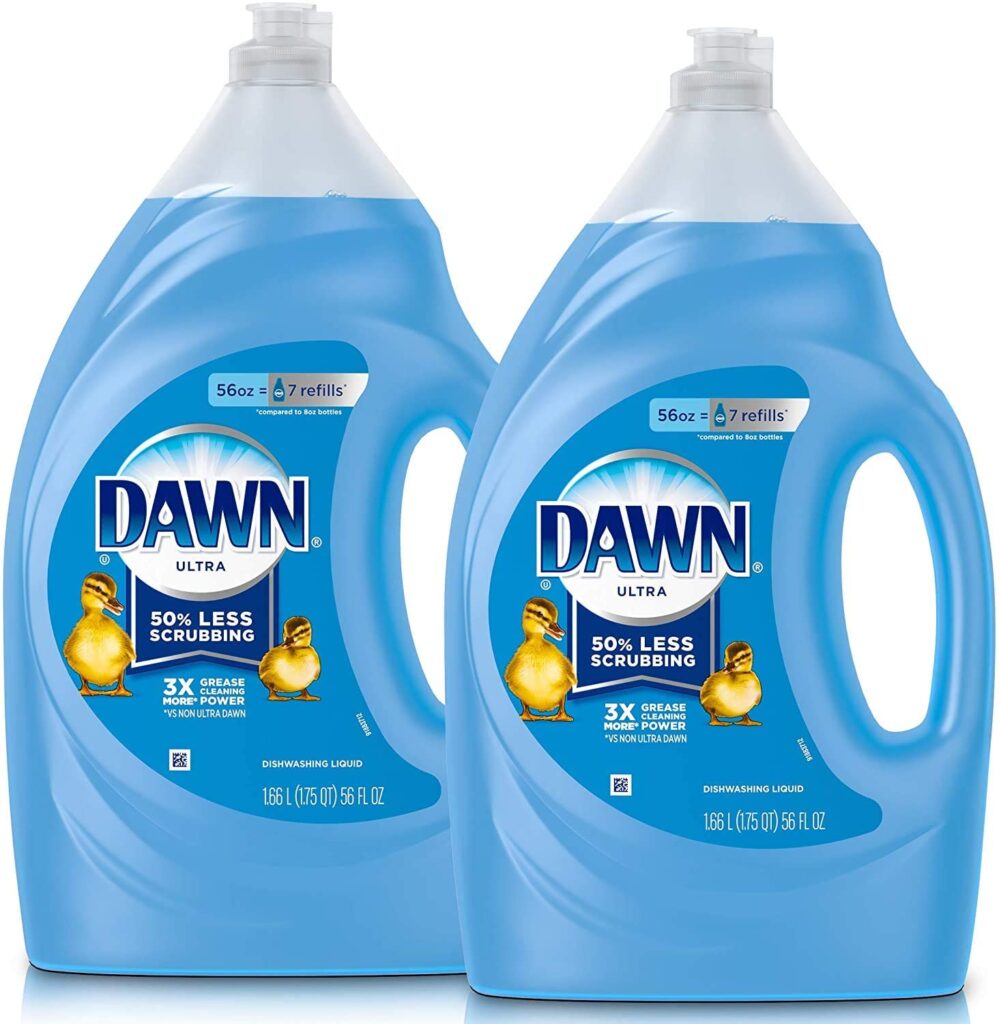
Dawn dish soap for the spider mite treatment
To treat spider mites on indoor plants:
- Take 4 to 5 tablespoons of mild dish soap per gallon of water
- Mix the ingredients thoroughly, pour into a spray bottle, and apply to infested plants
- Make sure to coat the infested leaves for effective spider mite treatment entirely
Use Rubbing Alcohol
To treat spider mites effectively, rubbing alcohol spray is the best and most practical. Because it also controls the whiteflies, aphids, mealybugs, scale insects, russet mites, and fungus gnats.
To Prepare The Rubbing Alcohol Spray
- Take 1/2 to 1 cup of rubbing alcohol with one quart of water in a bowl
- Mix the ingredients thoroughly and pour into a spray bottle
- Make sure to shake the spray bottle before every application
- Always prepare a new spray and uniformly coat the plant foliage
Treat Spider Mites With Neem Oil Spray
Neem oil is a triple-action (kills pests, mites, and fungal pathogens) spray used to treat spider mites. This oil spray contains azadirachtin—an active compound to kill spider mites from houseplants.
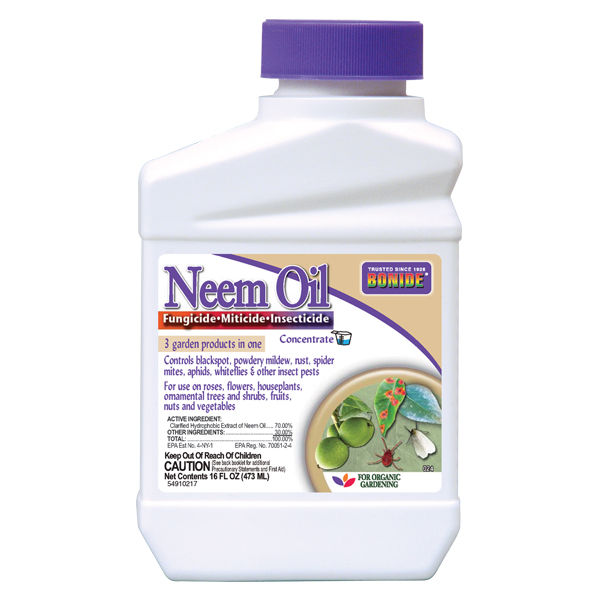
BONIDE Neem oil to treat spider mites
The neem oil spray works on these pesky mites by interfering with their growth, molting, feeding, mating, egg-laying cycle.
To Prepare The Neem Oil Spray:
- Take one oz per gallon of water in a large bowl. Add one oz of dish soap as an emulsifier into the mixture
- Thoroughly mix the ingredients and pour them into the spray bottle
- Spray the neem oil mixture to treat the severe infestation on houseplants
- Reapply the mixture at weekly or biweekly intervals
The pros of neem oil spray are that it can be applied throughout the planting season and can kill spider mites at all phases of their life cycle. Moreover, it is non-toxic to humans and pets.
Use Apple Cider Vinegar Spray
Apple cider vinegar, and baking soda are also effective and practical approaches to treating spider mites on contaminated plants. The spray of this mixture wash off the adults and kill their eggs, thus stopping their next-generation cycle.
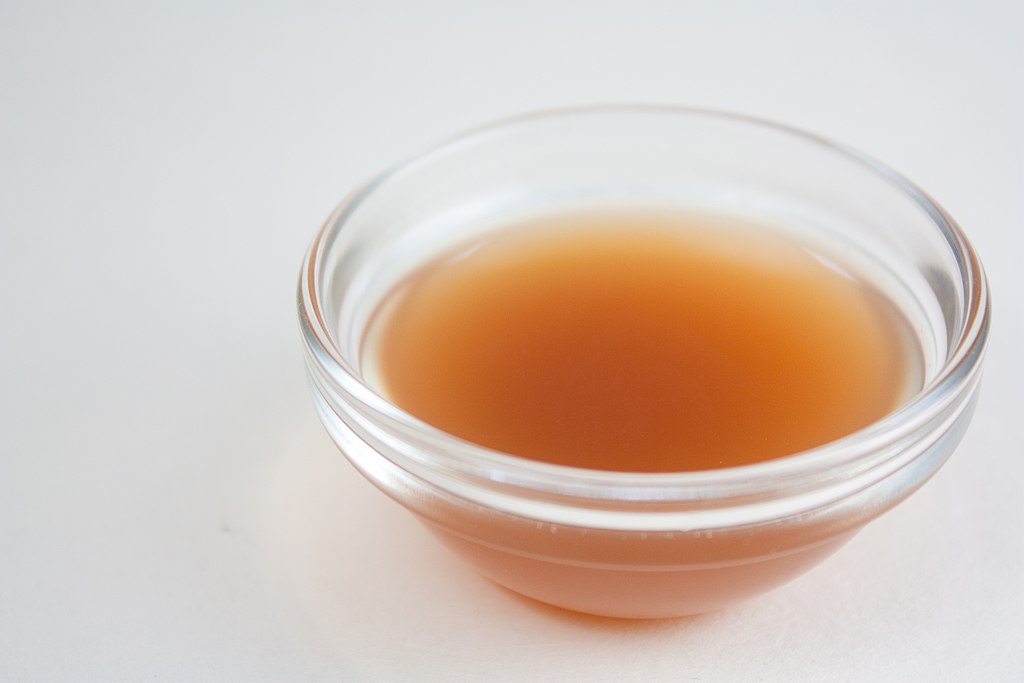
Apple cider vinegar to treat spider mites on houseplants
To Prepare The Apple Cider Vinegar Spray, We Need
- Take 2 to 4 tablespoons of vinegar, one tablespoon of baking soda, and a few drops of liquid dish soap per one liter of lukewarm water.
- Mix all the ingredients thoroughly and put them into a spray bottle
- Spray on houseplants whenever you spot spider mites infestations
- Do not over-apply and spray plants when high temperatures
Encourage Beneficial Insects
The natural enemies of spider mites actively feed on them and eliminate their populations on houseplants. One such example of predation is Phytoseiulus persimilis which actively feed on two-spotted mites and all stages.
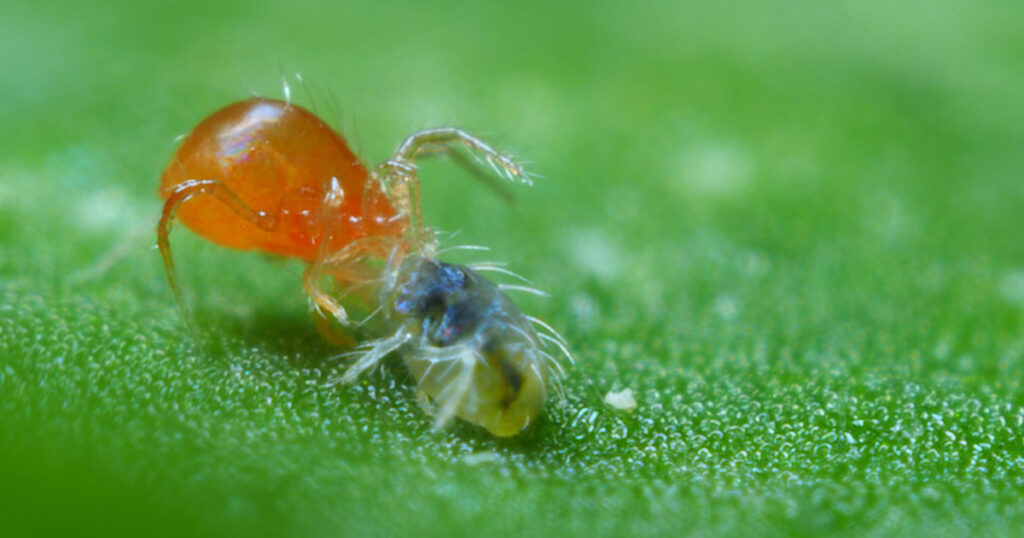
Phytoseiulus persimilis—actively feeding on two-spotted spider mites
The green lacewings, ladybird beetle, and spined soldier bugs are also the natural enemies of spider mites.
These natural predators in outdoor environments can easily control spider mites. However, in indoor spaces, these beneficial insects require many spider mites for their establishment. Once they are established, these beneficial insects control spider mites successfully.
Frequently Asked Questions
What Kills Spider Mites Naturally?
The absence of ideal growth conditions for spider mites kills them. Because these tiny creatures only survive and thrive when the weather is warm and dry with low humidity levels. If they infest your houseplants, the best way to remove them is to keep the potting soil moist but not over-saturated with water.
What Kills Mites Instantly?
Nuke Em is a new kind of organic pesticide that instantly kills the pests of indoor plants. It effectively kills organic gardening pests at all stages—eggs, larvae, pupae, and adults. This organic gardening insecticide contains citric acid as an active ingredient and requires three applications for complete control.
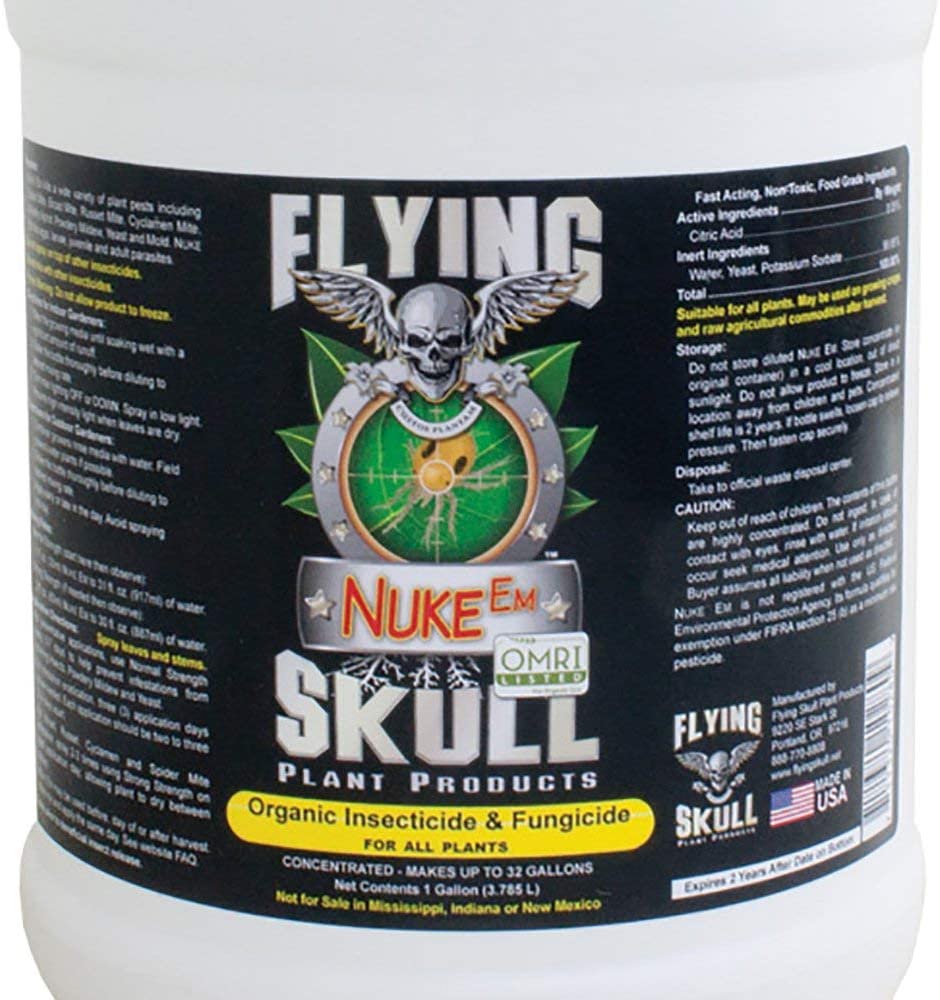
Nuke Em for the management of spider mites
The pros of using Nuke Em are, it does not leave any residue on foliage and is not toxic to humans and pets.
How Can You Tell The Difference Between Spider Mites And Spiders?
The difference between spider mites and spiders:
| Spider Mites | Spiders |
| Only visible through a magnifying glass or hand lens | Visible to the naked eye |
| They tend to make delicate webs when in high numbers | Garden spiders make webs on top of the plants and between the branches, |
| Web is soft and sticky and completely wrap the foliage | Do not cover the vegetation and web is highly geometric |
Sources for Further Reading
- Planet Natural. (2019, November 11). How to Get Rid of Spider Mites. Retrieved March 24, 2022, from https://www.planetnatural.com/pest-problem-solver/houseplant-pests/spider-mite-control/
- Managing Spider Mites on Houseplants. (n.d.). UMN Extension. Retrieved March 24, 2022, from https://extension.umn.edu/news/managing-spider-mites-houseplants
- Spider Mites On Indoor Plants. (n.d.). University of Maryland Extension. Retrieved March 24, 2022, from https://extension.umd.edu/resource/spider-mites-indoor-plants
Now that you know how to control spider mites on houseplants, read our other articles:
Black Beetles 101: Types and A Comprehensive Identification Guide with Pictures
Black Caterpillar Types: How to Identify Common Species, Fun Facts and More!
Furry Caterpillar Types with An Identification Guide, Fun Facts, and Pictures







